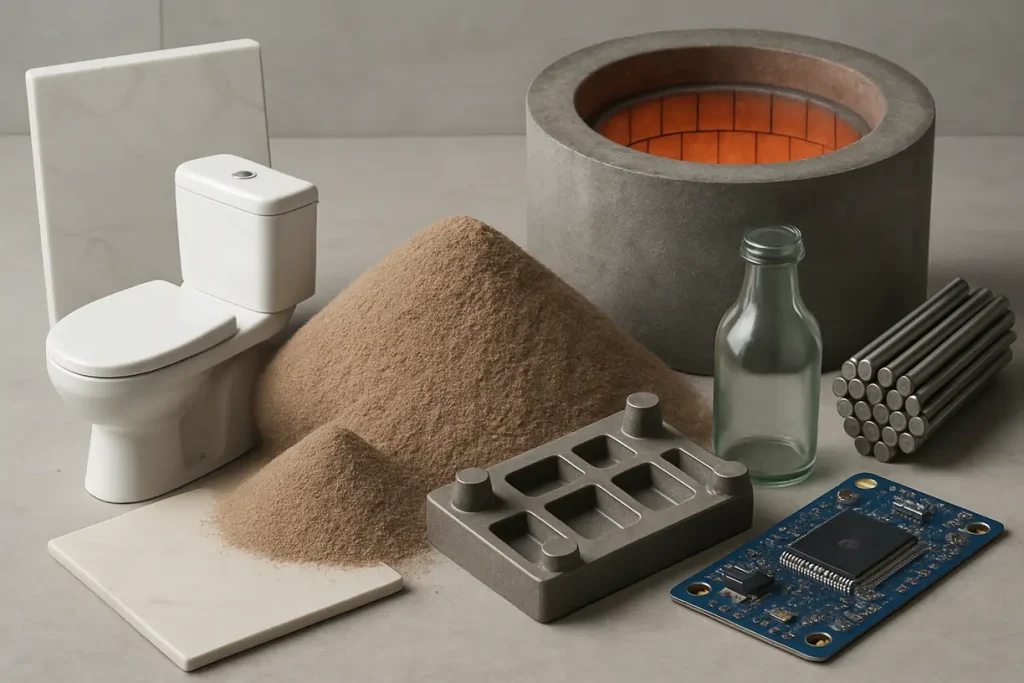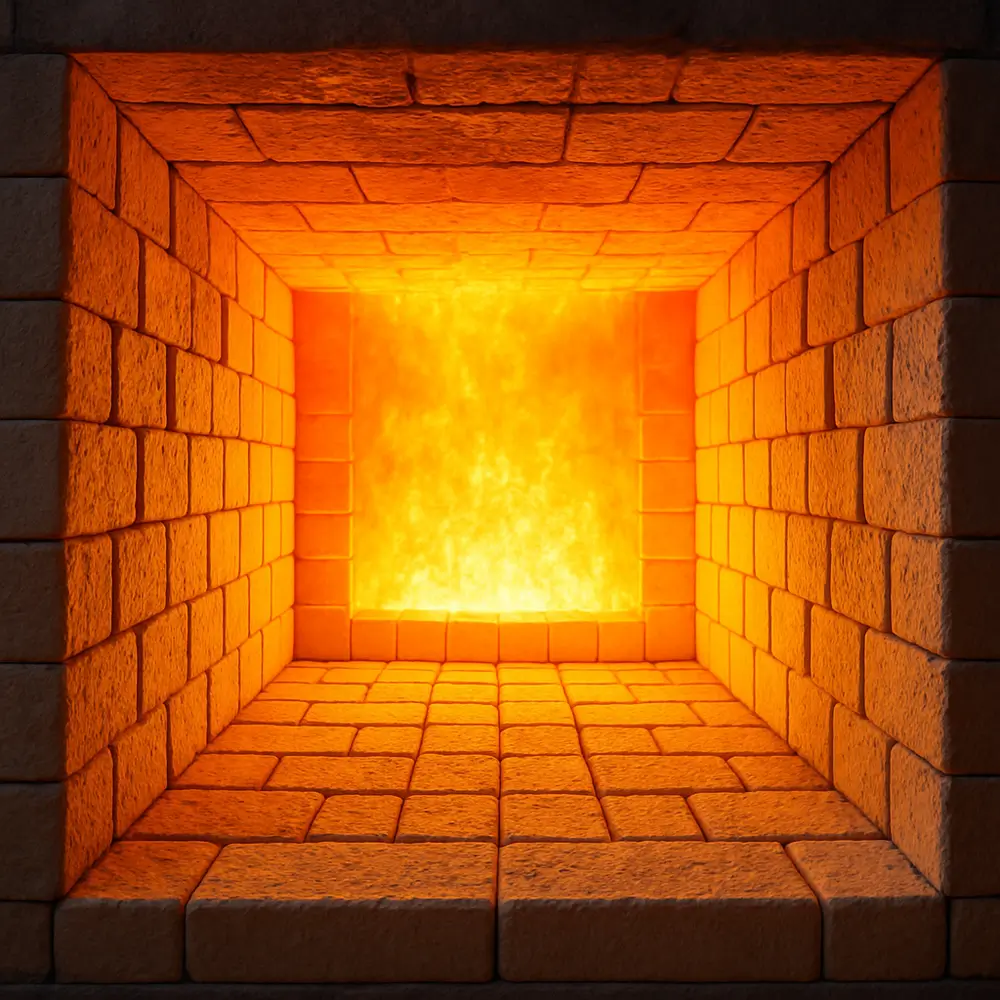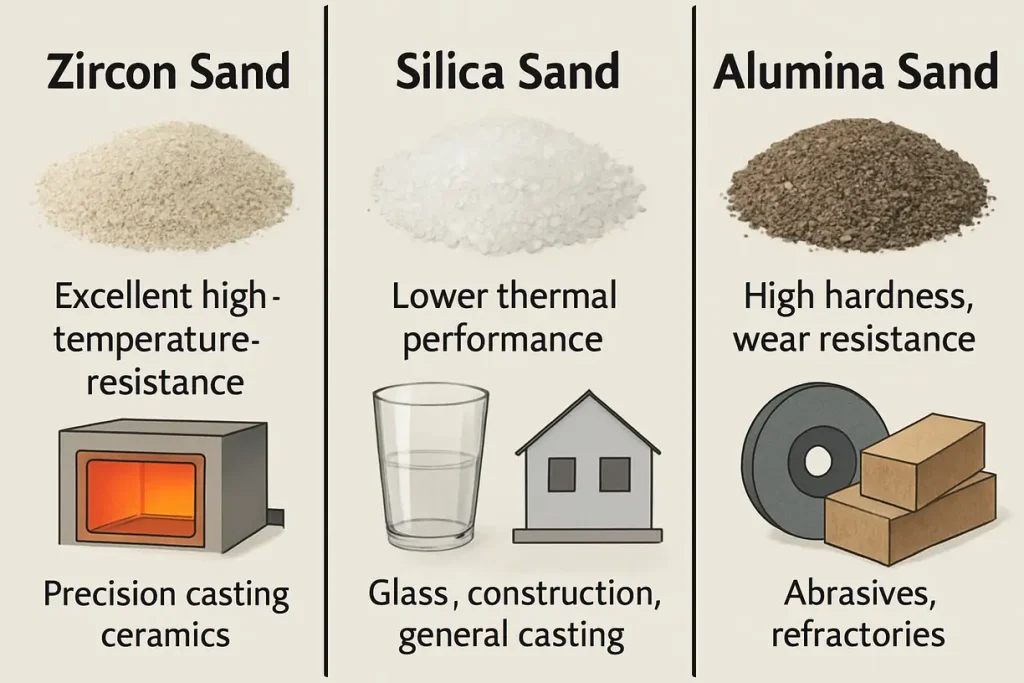Zircon sand plays a vital role in many industries due to its unique thermal properties, which set it apart from other materials. Companies often face challenges when selecting appropriate materials that can withstand high temperatures without compromising performance. This article will clearly explain the unique characteristics of zircon sand, providing insights into its thermal properties to help you make informed decisions in material selection. By understanding its advantages, businesses can gain a competitive edge by enhancing product quality and performance. Moreover, the insights provided here are based on reliable data and industry expertise, establishing a trustworthy context for the information presented.

This image illustrates the diverse applications of zircon sand across various industries, showcasing its versatility and importance.
Why Are Zircon Sand’s Thermal Properties Important?
Understanding the importance of zircon sand’s thermal properties is essential for businesses across various manufacturing sectors. These thermal characteristics are key to evaluating how a material responds when exposed to temperature variations, directly impacting its performance under heat and stress. In high-temperature applications, the choice of material can significantly influence both safety and efficiency, making it crucial for organizations to select suitable options that will meet their specific operational requirements.
Zircon sand is renowned for its exceptional heat resistance, making it an invaluable resource in sectors where high temperatures are criteria for reliability and performance. This includes industries such as aerospace, metalworking, ceramics, and even electronics. In all of these fields, the thermal stability associated with zircon sand is vital; it helps maintain product integrity during processing and limits failures that may arise from thermal stress.
For instance, in the foundry industry, zircon sand is often utilized to produce molds and cores for metal casting. Its ability to retain shape and structural integrity even under extreme conditions prevents defects in final products, thereby ensuring a consistently high-quality output. Furthermore, the unique thermal properties of zircon sand contribute to energy savings during manufacturing processes, a vital consideration in an era where sustainability is becoming increasingly important.
So, what does this mean for your business? Opting for zircon sand can lead to enhanced product quality, reduced operational costs, and improved manufacturing efficiency, making it a sound investment for many industries.
What Are the Key Thermal Properties of Zircon Sand?
Zircon sand stands out among industrial materials due to several key thermal properties that differentiate it from other alternatives. Understanding these properties is essential for businesses that rely on thermal performance in their operations. The major thermal properties include:
- High Melting Point: Zircon exhibits an impressive melting point of around 2,000°C (3,632°F), making it exceptionally suitable for high-temperature applications across different sectors. This characteristic allows it to be combined with metals, ceramics, and other materials without degrading, thus ensuring that the finished product remains stable even in extreme heat environments.
- Thermal Conductivity: With relatively low thermal conductivity, this material acts as an effective insulator. This property is crucial in applications that require substantial heat retention, such as in furnace linings and foundry operations, where maintaining precise temperatures over extended periods is essential for quality control.
- Low Thermal Expansion: One of the most significant advantages of zircon sand is its low thermal expansion coefficient. This feature minimizes the risks of cracking or deformation when subjected to varying temperatures. Such stability is particularly vital in manufacturing processes where thermal cycling occurs, ensuring that products meet stringent quality and accuracy standards.
To illustrate the benefits and performance characteristics, here’s a comparison of zircon sand with some common alternatives:
| Property | Zircon Sand | Silica Sand | Alumina Sand |
|---|---|---|---|
| Melting Point (°C) | 2,000 | 1,650 | 2,100 |
| Thermal Conductivity (W/m·K) | 3.0 | 1.2 | 15.0 |
| Coefficient of Thermal Expansion (x10^-6/K) | 6.5 | 8.5 | 7.0 |
This table underscores why this material is often favored in high-heat environments. By incorporating it into manufacturing processes, businesses can significantly enhance product quality and performance while also achieving improved energy efficiency. Furthermore, the longevity of tools and components made from zircon-based materials can reduce replacement frequency, which provides additional cost savings over time.
How Do Zircon Sand’s Properties Benefit Manufacturing?
The thermal properties of zircon sand provide numerous advantages that significantly impact manufacturing efficiency and reliability. These benefits make it a pivotal material in production lines across various sectors. Some notable advantages include:
- Increased Durability: Products manufactured with this material can withstand extreme conditions over extended periods without degrading. This longevity not only prolongs their lifecycle but also enhances the overall reliability of finished goods, reducing the need for frequent replacements and maintenance.
- Cost-Effectiveness: While zircon sand might have a higher initial cost compared to alternatives, its remarkable durability translates to lower long-term expenses. By minimizing maintenance and decreasing the likelihood of production errors, businesses benefit from reduced operational costs, thus improving their profit margins. In industries where precision and reliability are paramount, the financial advantages become more pronounced over time.
- Improved Performance: Output products maintain their structural integrity at high temperatures, an essential criterion for sectors like aerospace and automotive, where component failure could lead to catastrophic results. The inherent reliability afforded by zircon materials means fewer disruptions during production processes, leading to enhanced safety and quality assurance.
As a case in point, consider the metal casting industry. The stability of zircon sand ensures that molds maintain their shapes during high-temperature pouring processes. This stability helps prevent defects such as rough surfaces and dimensional inaccuracies, ultimately ensuring a higher quality in final products. The reduction in waste due to defective parts represents not just resource savings but also enhances overall production efficiency.
In summary, utilizing high-quality zircon sand can significantly streamline manufacturing processes and lead to substantial long-term savings, fostering enhanced operational efficiency while maintaining the highest standards of quality.uring processes and contribute to substantial long-term savings, promoting enhanced operational efficiency.
What Role Does Zircon Sand Play in Refractory Applications?
Zircon sand is a critical material used in refractory applications, specifically serving industries that require exceptional heat-resistant materials. Refractories play a crucial role in containing heat in high-temperature furnace linings and kilns, which are essential for the production of various materials. The use of zircon sand in these applications not only provides multiple advantages but also broadens its versatility across different industrial sectors.
One of the primary benefits of zircon sand in refractory applications is its ability to withstand extremely high temperatures without losing structural integrity. This feature makes it indispensable in industries involved in the production of metals, ceramics, and glass. For instance, in metal smelting operations, the material’s high melting point ensures that furnace linings remain intact, even under the extreme conditions of molten metal. The unique properties of zircon sand allow it to resist thermal shock, a critical requirement in environments where rapid temperature shifts can occur, thereby reducing the risk of cracking or failure.
Moreover, zircon sand is frequently employed for manufacturing bricks, tiles, and other structures that need to withstand harsh thermal environments. These components are essential in the production of ceramics and glass, where maintaining high-quality outputs is paramount. By utilizing this material in their processes, manufacturers can ensure better thermal performance, leading to enhanced product durability and a longer operational lifespan for their equipment.
To highlight its significance, here’s a snapshot of where zircon sand finds utility in refractory materials:
| Application | Use of Zircon Sand |
|---|---|
| Steel Industry | Furnace linings with high durability |
| Cement Production | Kiln linings that withstand extreme heat |
| Glass Manufacturing | Glass melting pots that need to retain high temperatures |
| Ceramics | High-temperature molds that need stability |
This table outlines typical use cases and demonstrates the versatility of zircon sand in refractory applications. By using materials with optimal thermal characteristics, companies can expect improved reliability and performance in demanding conditions, positively impacting overall production outcomes.

This image shows a furnace lined with zircon sand bricks, illustrating its application in high-temperature settings.
How Does Zircon Sand Handle Thermal Shock?
Thermal shock occurs when materials experience sudden temperature changes, which can lead to physical stress and, ultimately, product failure. Zircon sand excels in handling thermal shock due to its unique composition and properties.
- Resistance to Cracking: One of the significant attributes of zircon sand is its low thermal expansion. This minimizes the stress caused by rapid temperature changes, allowing it to resist cracks that could lead to significant failures or safety issues.
- Applications with High Thermal Shock Risks: This material is ideal for applications in industries like aerospace and metalworking, where components face significant temperature variations during their operational lifecycle.
For example, in high-stakes environments like rocket engine manufacturing, parts must endure extreme heat during launch and subsequent cooling upon descent. The components made from zircon sand can reliably perform under these conditions, ensuring that safety standards are met and that the performance does not diminish.
In conclusion, understanding how zircon sand manages thermal shock is vital for making informed material choices in any project that requires high-performance components.
How Can Thermal Properties of Zircon Sand Be Measured?
Accurate measurement of thermal properties is pivotal for quality control, engineering standards, and the overall assurance of material reliability. Various methods exist to evaluate the thermal characteristics of zircon sand, which include:
- Differential Scanning Calorimetry (DSC): This method offers high accuracy in determining the material’s melting point and heat capacity, allowing businesses to evaluate thermal limits efficiently.
- Thermogravimetric Analysis (TGA): By measuring how a material’s weight changes with temperature, TGA can assist in identifying thermal stability, providing insights needed to ensure quality.
- Laser Flash Analysis (LFA): This innovative technique measures thermal diffusivity, which is vital for understanding heat transfer properties. It offers quicker results in assessing performance.
The choice of method can significantly affect the accuracy of the measurements. Here is a comparison of the different analysis techniques:
| Method | Advantages | Disadvantages |
|---|---|---|
| Differential Scanning Calorimetry | High accuracy | Requires calibration |
| Thermogravimetric Analysis | Effective for stability evaluations | May not work at very high temperatures |
| Laser Flash Analysis | Fast results | Equipment cost can be high |
Deciding on the appropriate measurement method depends on the specific properties of interest and the resources available, and it reflects a company’s commitment to quality and performance.
What Are the Environmental Impacts of Using Zircon Sand?
While zircon sand has many advantages, it is essential to consider its environmental impact when discussing its use. The process of mining can lead to various challenges, including habitat disruption and pollution.
- Sustainability Concerns: Businesses must adopt responsible mining practices to mitigate adverse effects on the environment. Many companies are actively investing in rehabilitation efforts to restore mined lands, which underscores their commitment to sustainability.
- Innovations in Mining: There is a growing trend toward the use of less invasive extraction methods and recycling waste materials, which helps to reduce the environmental footprint associated with zircon sand production.
Here’s a look at some sustainable environmental practices currently being implemented within the industry:
| Practice | Description |
|---|---|
| Responsible Mining Initiatives | Programs designed to minimize harm to natural ecosystems |
| Land Rehabilitation Programs | Efforts to restore landscapes after the mining activities conclude |
| Reduced Water Usage | Innovative techniques aimed at conserving water during extraction processes |
Understanding and implementing these practices is vital for businesses in the industry. Moreover, it demonstrates a commitment to social responsibility and sustainability, which can enhance a company’s reputation in an increasingly eco-conscious market.
How Does Zircon Sand Compare to Alternatives?
When it comes to high-temperature applications, evaluating alternatives to zircon sand is crucial. Understanding how zircon sand stacks up against other materials can lead to better material choices that enhance performance.
- Silica Sand: While often less expensive and readily available, silica has a lower melting point and less thermal stability compared to zircon. It may be suitable for some applications, but it often lacks the heat resistance needed in critical operational conditions.
- Alumina Sand: Though alumina offers high thermal resistance, it can be significantly more costly. Alumina products may also require additional processing, leading to increased production times and operational costs.
Here’s a comparative table summarizing the performance of zircon sand against alternatives:
| Property | Zircon Sand | Silica Sand | Alumina Sand |
|---|---|---|---|
| Melting Point (°C) | 2,000 | 1,650 | 2,100 |
| Thermal Resistance | High | Moderate | High |
| Cost Per Unit | Higher | Lower | Higher |
By analyzing these advantages and disadvantages, businesses can make informed decisions to align material choices with thermal performance needs and budget constraints, ensuring optimal output in their operations.

This image compares zircon sand with silica and alumina sands, highlighting differences in thermal properties and usage.
How to Select the Right Type of Zircon Sand for Your Needs?
Identifying the proper type of zircon sand for any project is vital and can significantly influence the outcome and performance. Here are some essential factors to consider during the selection process:
- Chemical Composition: Variations in zircon sands exist depending on their chemical makeup, which can directly affect thermal performance. Businesses must analyze their unique project requirements to determine which zircon composition suits their needs best.
- Grain Size: The grain size can influence how the sand behaves during manufacturing. Larger grains may provide better flow properties for specific applications, while finer grains may deliver different benefits, such as improved mold filling. Understanding these nuances can aid in the selection process.
- Sourcing Quality Materials: It is critical to choose suppliers that provide high-quality zircon sand, coupled with reliability and performance records. Establishing good relationships with trusted suppliers can lead to improved supply chain management and assurance of quality.
For easier evaluation, here is a simple checklist:
| Factor | Consideration |
|---|---|
| Chemical Composition | Align with project requirements for optimal performance |
| Grain Size | Ensure suitability for the intended application |
| Supplier Reliability | Choose trusted vendors with quality assurance protocols |
Ultimately, understanding these factors will help you select the correct type of zircon sand tailored to your project’s specific thermal performance and operational needs.
What Future Developments Are Anticipated for Zircon Sand?
The future of zircon sand holds promising opportunities for innovation and expanded applications, primarily driven by advancements in technology and material science. Emerging developments may enhance its performance across various industries.
- New Processing Techniques: Advances in extraction and refinement methods have the potential to yield higher purity zircon sand, which would improve its thermal and operational properties even further.
- Sustainable Practices: As awareness around environmental sustainability grows, the demand for eco-friendly mining and production methods will likely increase. Companies that adapt to these practices will position themselves favorably in competitive markets.
- Expanded Applications: As industries evolve to embrace new technologies, the demand for materials featuring unique thermal properties akin to those of zircon sand is projected to grow. New markets may surface in areas such as renewable energy, electronics, and even nanotechnology applications.
A look at potential developments is reflected in the following table:
| Development | Description |
|---|---|
| Advanced Processing Techniques | Higher purity and improved performance |
| Eco-friendly Initiatives | Sustainable mining and production methods |
| Broader Industrial Applications | New markets arising in emerging industries |
These advancements will undoubtedly shape the future landscape of zircon sand usage. As industries seek higher-performance materials, zircon sand is expected to remain a key player in high-performance applications.
Conclusion
This article has thoroughly explored the unique thermal properties of zircon sand and its significant advantages across various industries. By understanding these properties, businesses can enjoy increased durability, reduced costs, and improved product performance in high-temperature applications. Partner with Global Industry to access high-quality zircon sand tailored to your specific needs, and experience enhanced manufacturing processes. For more insights and additional resources on high-performance materials, visit our website, ensuring your projects utilize the best materials available for optimal outcomes.
FAQ Section
Q1: What are thermal properties?
Thermal properties refer to a material’s behavior in response to temperature changes. These properties include parameters such as melting point, thermal conductivity, heat capacity, and expansion characteristics, which are critical for determining how a material performs under various temperature conditions.
Q2: How is zircon sand sourced?
Zircon sand is typically extracted from mineral sand deposits found both on land and under the sea. Mining operations often involve techniques such as open-pit mining or dredging, followed by processing to purify the sand for industrial use. Responsible sourcing practices are essential to minimize environmental impact during extraction.
Q3: Why is zircon sand preferred for refractory applications?
This material is highly regarded in refractory applications due to its high melting point and low thermal expansion, which make it capable of withstanding extreme temperatures without deformation. Additionally, its resistance to thermal shock ensures that it maintains structural integrity during rapid temperature changes, essential for efficiency in high-temperature environments.
Q4: What industries benefit most from zircon sand’s thermal properties?
Industries such as aerospace, metal casting, and ceramics significantly benefit from the unique thermal characteristics of zircon sand. Its superior heat resistance enhances the performance and durability of components in these sectors, which are often subject to extreme conditions during manufacturing and operational use.
Q5: Are there any concerns regarding zircon sand mining?
Yes, there are concerns related to environmental impact, such as habitat destruction and pollution during mining operations. However, many companies are adopting environmentally responsible practices to mitigate these effects, including land rehabilitation and the use of sustainable mining techniques to protect natural ecosystems.
